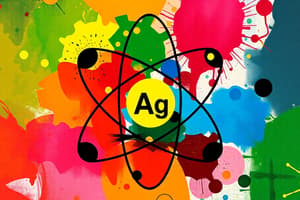Podcast
Questions and Answers
What is the definition of atomic radius (AR)?
What is the definition of atomic radius (AR)?
- The distance between protons and neutrons in the nucleus.
- The radius of a neutral atom.
- The average distance between the outer electrons and the nucleus. (correct)
- The radius of a cation or an anion.
Why does the ionic radius of an anion increase as it gains electrons?
Why does the ionic radius of an anion increase as it gains electrons?
- Due to effective nuclear charge increasing and electron cloud contracting.
- Due to effective nuclear charge being reduced and electron cloud expanding. (correct)
- Due to electron cloud expanding but effective nuclear charge remaining constant.
- Due to no change in effective nuclear charge and electron cloud size.
Which sublevel is involved in the formation of Fe+3 ion?
Which sublevel is involved in the formation of Fe+3 ion?
- $4s^1 3d^5$
- $4s^0 3d^5$ (correct)
- $4s^2 3d^6$
- $4s^2 3d^5$
What happens to the effective nuclear charge as cations are formed?
What happens to the effective nuclear charge as cations are formed?
In comparison to a neutral atom, how does the ionic radius of an anion (X-2) typically relate?
In comparison to a neutral atom, how does the ionic radius of an anion (X-2) typically relate?
Flashcards are hidden until you start studying
Study Notes
The Periodic Table
- The Periodic Law is the arrangement of elements in order of increasing atomic number, with repetition of their physical and chemical properties.
- Electron configurations of any element can be determined from its position in the Periodic Table.
s-Block Elements
- Group 1 (1A) elements end with ns1 configuration (alkali metals).
- Group 2 (2A) elements end with ns2 configuration (alkaline earth metals).
p-Block Elements
- General configuration: ns2np1, ns2np2, ns2np3, ns2np4, and ns2np5.
- Includes halogens.
Ion Formation
- General rule: remove all electrons with the highest ns value.
- For metals:
- Remove ns electrons first.
- Examples: Na ([Ne] 3s1) → Na+ ([Ne] 3s0), Mg ([Ne] 3s2) → Mg+2 ([Ne] 3s0), Al ([Ne] 3s2p1) → Al+3 ([Ne] 3s0p0).
- For non-metals: add electrons to the highest np orbital.
Studying That Suits You
Use AI to generate personalized quizzes and flashcards to suit your learning preferences.




